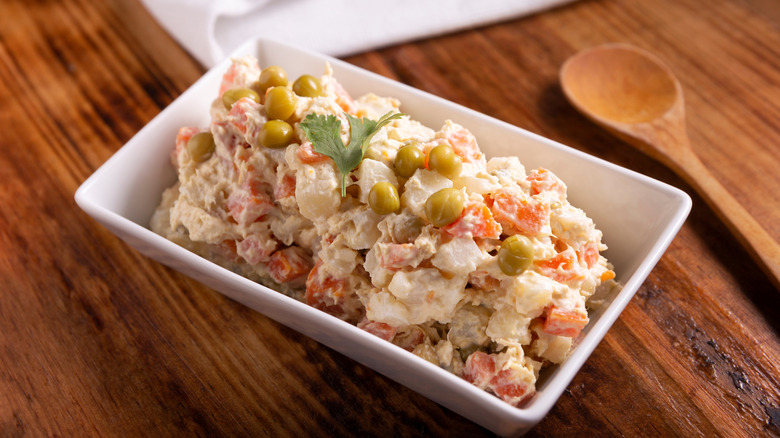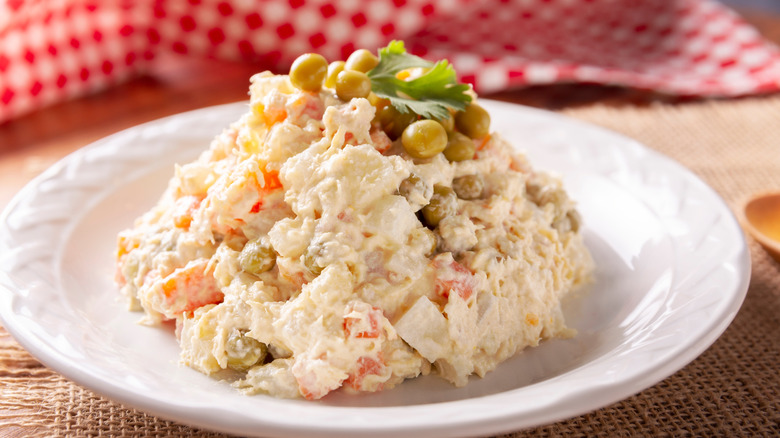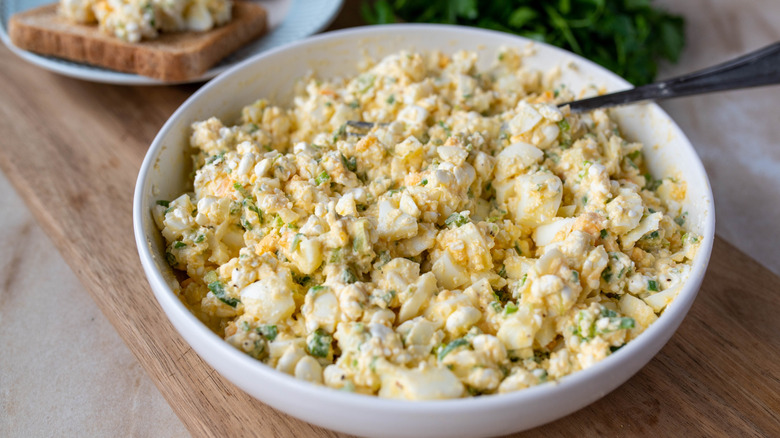What Exactly Is Russian Egg Salad And How Is It Different From The Rest?
Egg salad is perhaps one of the most humbly delicious and instantly recognizable dishes in the world. While the basic components of the salad — eggs and dressing (usually mayonnaise) — remain consistent, each culture puts its own unique spin on the ingredients and assembly. For a version hearty and filling enough to stand alone as a main dish, look no further than Olivier Salad, also known as Russian egg salad.
Blurring the line between egg salad and potato salad, this popular Eastern European dish traditionally features boiled eggs and potatoes, along with carrots, pickles, peas, and a generous dollop of mayonnaise. Many modern recipes for Russian salad also include cold protein, such as ham or chicken, as well as other crunchy vegetables like onions, celery, and cucumbers. Some people enjoy adding seafood, such as shrimp or crab meat, to their Russian salad, while others incorporate a touch of sweetness by mixing in apples or pickled mango.
The mysterious origins of Russian salad
The origins of the Russian salad recipe, as well as its inventor, Moscow-born restaurateur Lucien Olivier, remain somewhat shrouded in mystery. While the common story is that Olivier was born in Russia to French or Belgian parents, some theorize that the chef — whose given name was Nikolai — was of full Russian heritage and later adopted a Francophone name. A dedicated student of French cooking, Olivier opened Moscow's first fine dining restaurant, The Hermitage, in 1864. The restaurant became the birthplace of what would come to be known as Olivier Salad, though the dish was first listed on the menu as Game Bird Mayonnaise.
Influenced by the decadent French salads of the era, Olivier's original dish was said to feature layers of game hen, smoked duck, and capers, garnished with crayfish tails, veal tongue, and rich Provençal mayonnaise, and decorated with potato skins, gherkins, and boiled eggs. However, the true recipe for this luxurious salad was kept a secret, one that Olivier took to his grave in 1885. Still, the legacy of Olivier Salad lived on, with significantly simplified versions of the dish appearing in popular cafés and cookbooks in the decades following his death. Today, Olivier Salad is so cherished in Russian culture that many families prepare it annually for New Year's celebrations.
More egg salads from around the world
Russia certainly isn't the only country to boast its own special style of this dish — in fact, there are many international renditions of egg salad, with unique versions found on nearly every continent. When compared to the layered components of the Russian potato-and-pickle adorned dish, the classic American egg salad is relatively simple, relying on mayonnaise, mustard, lemon juice, and herbs like chives and scallions to flavor the eggs. French oeuf mayonnaise is similarly straightforward, using the same main ingredients as the American version, but the difference lies in the presentation: The creamy mayo and mustard-based dressing is dolloped on top of whole (or halved) boiled eggs, rather than mixed into chopped eggs.
There are also several international variations of the dish that forgo mayonnaise altogether. In Poland, cream cheese is used to create a luscious egg salad that's thick enough to serve as a dip or spread onto a bagel. Hungarian egg salad, studded with capers, relies on a tangy mix of sour cream, white vinegar, and butter to set it apart.
Another delightfully tart take on the dish comes from Senegal, where the beloved salade cote cap verte is made by dressing salad greens and chopped eggs with tarragon vinegar. Meanwhile, in China's Sichuan province, salty and pungent preserved eggs — known as century eggs — are sliced and topped with garlic, soy sauce, vinegar, and chili oil to create a spicy, umami-rich dish called pidan.



